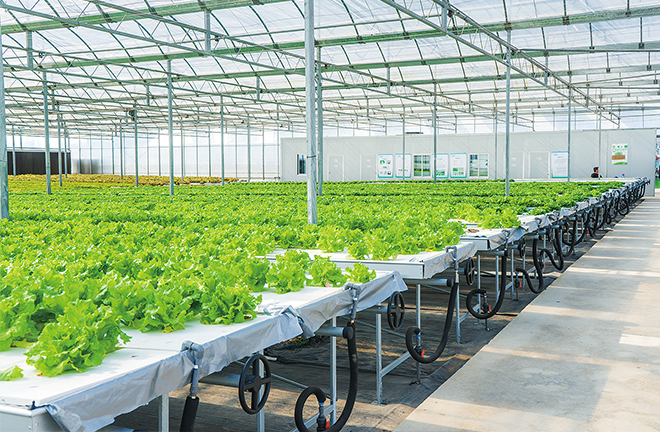Promoting China’s sustainable agricultural development

Eco-farming integrates efficient sustainable agricultural technology with traditional farming techniques. Photo: TUCHONG
China’s Central Rural Work Conference held in December 2024 emphasized the need to accelerate the modernization of agriculture and rural areas to further consolidate the foundation of agriculture. In the context of global climate change and food security pressures, achieving agricultural modernization has become an increasingly crucial issue.
Challenges in agricultural modernization
To accelerate agricultural and rural modernization, it is essential to first recognize the primary challenges facing China’s agricultural development in the new era, namely climate change and food security. Climate change exerts far-reaching impacts on the economy, society, and culture, with its most immediate effects manifesting in agricultural production. This has led to a growing call for sustainable agricultural development and an increasingly diverse array of green agriculture practices.
According to data released by the Ministry of Agriculture and Rural Affairs of the PRC, food production and consumption in China are largely balanced. However, according to the 2021 China Rural Development Report, compiled by the Rural Development Institute of the Chinese Academy of Social Sciences, by 2035, China will need to ensure a total food supply capacity of 900 million tons to meet higher-level domestic food consumption needs.
Under pressure to increase food production, several major grain-producing regions have opted for large-scale farming and agricultural mechanization to boost yields. Both large agricultural companies and small-to-medium cooperatives seek to address agricultural labor shortages through capital and technological investments, while increasing the value added per unit of output through the secondary and tertiary sectors. Although this approach is conducive to ensuring food security, increasing agricultural output value, and raising farmers’ income, it has several shortcomings.
Firstly, amid globalization and marketization, agriculture has become more vulnerable to external market forces, losing pricing power over key factors such as land and labor. As a result, agricultural profits have steadily declined, and many rural workers have migrated to other sectors. Secondly, market risks rise as production scales expand. Recent years have seen phenomena such as vegetables rotting in the fields due to oversupply, which sound a cautionary note. Thirdly, profit-driven practices have led to soil and water pollution as well as seed and food safety issues.
Rediscovering value of traditional agriculture
While large-scale farming can increase output and lower costs, it tends to overlook the value of labor. Farmers, unwilling to invest their labor in agricultural production, migrate to the secondary and tertiary sectors, resulting in a massive exodus from rural areas. Consequently, rural areas and agriculture are falling into decline.
Agricultural modernization should not aim to replace traditional agriculture, but rather to learn from and innovate upon it. In recent years, eco-farms have emerged across China. Eco-farming is grounded in ecological theories and adheres to the principle of sustainability, integrating efficient sustainable agricultural technology with traditional farming techniques. Indeed, certain composting, pest control, and weeding techniques adopted by eco-farms are rooted in thousands of years of Chinese agricultural heritage.
American agricultural scientist Franklin Hiram King once lauded East Asian agriculture for its ability to employ Western technologies while preserving traditional farming culture and techniques that align with the laws of nature. He argued that learning from East Asian agricultural systems could help resolve issues such as eutrophication and soil pollution that threaten the sustainability of American agriculture.
Coordinated urban-rural development
As eco-friendly, organic produce carries higher value added, farmers can earn greater profits by improving food quality. If agricultural income equals or exceeds income from urban employment in the secondary and tertiary sectors, migrant workers may return and even attract higher-quality labor to the sector. Furthermore, remarkable technological breakthroughs have been made in China’s sustainable agriculture. These advancements not only boost farmers’ income and offer consumers more diverse choices, but also demonstrate considerable potential for reducing carbon footprints.
In addition to food provision, agriculture serves numerous other functions. The US, a pioneer of large-scale farming, has profoundly reassessed its agricultural practices since the beginning of the 21st century. With the rise of small-scale family farms, community-supported agriculture, and the organic food industry, urban agriculture is gaining popularity. In this model, urban residents produce agricultural products locally in community gardens for distribution in farmers’ markets. Similar initiatives include suburban farms that engage in small-scale farming and animal husbandry.
The “produce locally, consume locally” model offers consumers fresher, healthier food while also reducing greenhouse gas emissions associated with storage, packaging, and transportation. Exploring the diverse functions of agriculture and creatively promoting sustainable agricultural in its various forms play an important role in advancing coordinated urban-rural development.
Zhang Feinai is a research fellow from the Institute of Borderland Development at Heilongjiang Academy of Social Sciences.
Edited by WANG YOURAN
